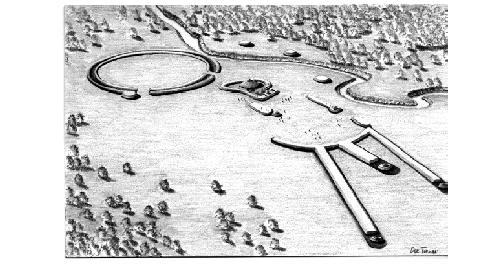 | ||
Above: Fort Center, Florida mound complex reconstruction by Dee Turman. © 2007 & 2008—reproduction on websites or by any other means strictly prohibited. | ||
Citations from: The Illustrated Encyclopedia of Native American Mounds & Earthworks Released 2009 by Dr. Greg Little Fort Center, Florida • Earthworks & Platform Mounds • Woodland Located on Fisheating Creek on the west side of Lake Okeechobee, FL. Few people realize the complexity and extent of mound sites that were constructed in coastal Florida and Georgia. These sites consisted of huge pyramid-shaped platform mounds, linear embankments that, in some cases, extended for miles, and massive donut-shaped enclosures. Some of these sites contained dozens of mounds that were linked together in complex geometrical formations by earthworks. Many of these sites also had extensive canal systems that connected the mound complexes to nearby lakes, waterways, and even to the Atlantic coast and the Gulf of Mexico. The canals were typically 30 feet wide, 8 feet deep, and were as long as 30 miles. The mounds and earthworks were formed from sand, shell, and midden and probably date to as early as 3000 B.C. Because of the remoteness of the sites, many of the most impressive sites remain intact as well as publically unknown. One such site is Fort Center, Florida. Located near the Florida Everglades, Fort Center is a Woodland era complex of mounds and complex earthworks. Because the complex has complex circular embankments, linear embankments, and earthworks that have attached mounds, some archaeologists have suggest it is a Hopewell culture site. There were at least 12 mounds once located here, most of which were rounded platform mounds with a structure on the flat top. The site appears to date sometime between 450 B.C. to A.D. 200. Nearby is the Big Tony’s earthwork complex, which probably dates to the same time period and culture. | ||
 | ||